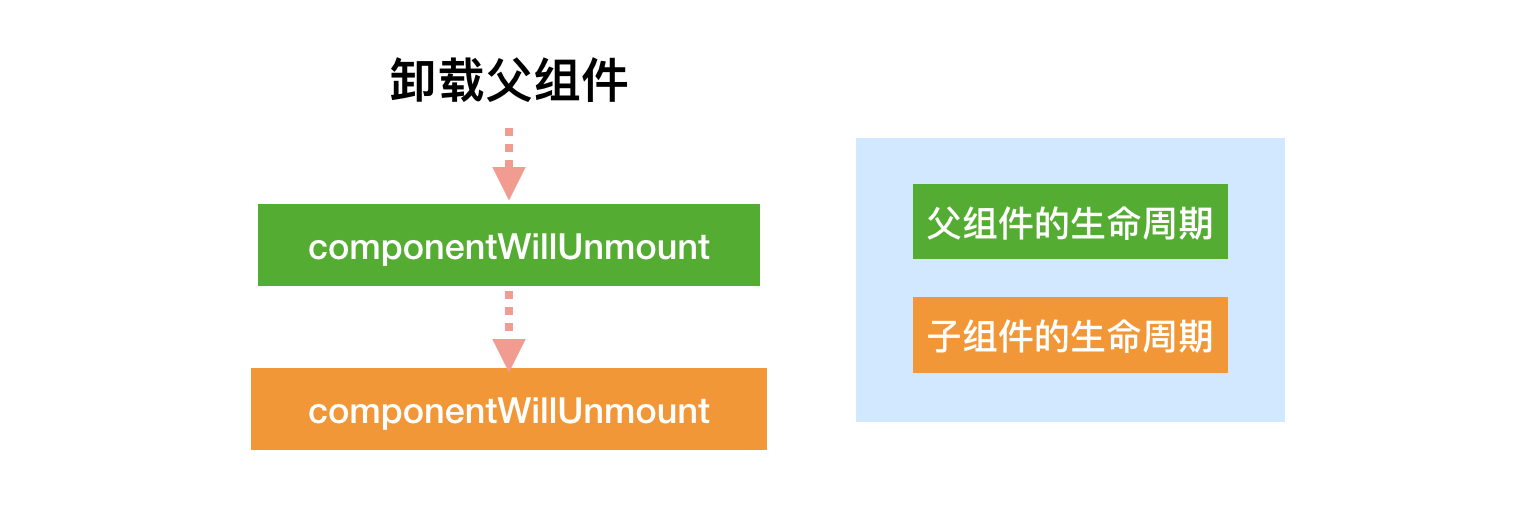React新旧生命周期一览
0 条评论React16.3.0开始,生命周期进行了一些变化。本文主要介绍React16.3.0之后的生命周期。
16版本之前的react组件的生命周期相信大家已经很熟悉。16版本的react对组件的生命周期函数进行了一些修改,下面进行详细说明。
React16.3.0之前生命周期
创建期:
- constructor(props, context)
- componentWillMount()
- render()
- componentDidMount()
运行时:
props发生变化时
- componentWillReceiveProps(nextProps, nextContext)
- shouldComponentUpdate(nextProps, nextState, nextContext)
- componentWillUpdate(nextProps, nextState, nextContext)
- render
- componentDidUpdate(prevProps, prevState, snapshot)
state发生变化时
- shouldComponentUpdate(nextProps, nextState, nextContext)
- componentWillUpdate(nextProps, nextState, nextContext)
- render
- componentDidUpdate(prevProps, prevState, snapshot)
卸载时
componentWillUnmount()
React16.3.0之后的生命周期
创建期:
- constructor(props, context)
- static getDerivedStateFromProps(props, status)
- render()
- componentDidMount()
或者如下生命周期:
- constructor(props, context)
- componentWillMount() / UNSAFE_componentWillMount()
- render()
- componentDidMount()
注意: getDerivedStateFromProps/getSnapshotBeforeUpdate 和 componentWillMount/componentWillReceiveProps/componentWillUpdate 如果同时存在,React会在控制台给出警告信息,且仅执行 getDerivedStateFromProps/getSnapshotBeforeUpdate 【React@16.7.0】
运行时:
props发生变化时
- static getDerivedStateFromProps(props, status)
- shouldComponentUpdate(nextProps, nextState, nextContext)
- render
- getSnapshotBeforeUpdate(prevProps, prevState)
- componentDidUpdate(prevProps, prevState, snapshot)
或者如下生命周期:
- componentWillReceiveProps(nextProps, nextContext)/UNSAFE_componentWillReceiveProps
- shouldComponentUpdate(nextProps, nextState, nextContext)
- componentWillUpdate(nextProps, nextState, nextContext)
- render
- componentDidUpdate(prevProps, prevState, snapshot)
state发生变化时
- static getDerivedStateFromProps(props, status)
- shouldComponentUpdate(nextProps, nextState, nextContext)
- render
- getSnapshotBeforeUpdate(prevProps, prevState)
- componentDidUpdate(prevProps, prevState, snapshot)
或者如下生命周期:
- shouldComponentUpdate(nextProps, nextState, nextContext)
- componentWillUpdate(nextProps, nextState, nextContext)/UNSAFE_componentWillUpdate
- render
- componentDidUpdate(prevProps, prevState, snapshot)
销毁时
componentWillUnmount()
新的生命周期图示:
生命周期详解
1.constructor(props, context)
constructor生命周期,如不需要,可缺省。通常会在 constructor 方法中初始化 state 和绑定事件处理程序。
但是,如果写了constructor,那么必须在其中调用super(props);否则可能会引起报错。
如:
class Base extends Component {
constructor(props) {
super(); //应该为 super(props);
}
state = {
name: this.props.name
}
//....code
}
抛出异常: Uncaught TypeError: Cannot read property ‘name’ of undefined.
同样,如果定义了context,在state中需要使用this.context去获取context上的内容,则需要super(props, context);
不过,如果你缺省constructor,那么在state中,可以放心的使用 this.props 或者是 this.context,不会引起报错。
class Base extends Component {
state = {
name: this.props.name,
color: this.context.color
}
//....code
}
初始化的state同样可以在constructor中定义。如果需要给方法绑定this,那么统一在constructor中进行。
2.static getDerivedStateFromProps(props, state)
当组件的state需要根据props来改变的时候可调用此方法。这个方法是在 render() 前会被执行,每次触发render前,都会触发此方法。
该方法有两个参数props和state; 返回值为state对象, 不需要返回整体state,把需要改变的state返回即可。如果不需要,可以返回null.
classBaseextendsComponent {
state = {
age:20
}
staticgetDerivedStateFromProps(props, state) {
return {
age:50
}
}
render() {
// 50return (
<div>{this.state.age}</div>
)
}
}
这个方法允许组件基于 props 的变更来更新其内部状态,以这种方式获得的组件状态被称为派生状态。应该谨慎使用派生状态,可能会引入潜在的错误
3.render
React组件中必须要提供的方法。当state或者props任一数据有更新时都会执行。
render() 是一个纯函数,因此,不要在其中执行setState诸如此类的操作。render必须有一个返回值,返回的数据类型可以有:
- null、String、Number、Array、Boolean。
- React elements
- Fragment
- Portal
注意不要在render中调用setState
4.componentDidMount
componentDidMount()方法是在组件加载完后立即执行,也就是当该组件相关的dom节点插入到dom树中时。该方法在组件生命中只执行一次。
一般情况,我们会在这里setState(),或者进行接口请求,设置订阅等。
classBaseextendsComponent {
state = {
age:20
}
componentDidMount() {
this.fetchDate();
}
render() {
return (
<div>{this.state.age}</div>
)
}
//other code
}
5.shouldComponentUpdate(nextProps, nextState, nextContext)
在渲染新的props或state前,shouldComponentUpdate被调用,默认返回true。forceUpdate()时不会调用此方法。
如果shouldComponentUpdate()返回false,那么getSnapshotBeforeUpdate,render和componentDidUpdate不会被调用。
此生命周期主要用于优化性能。
6.getSnapshotBeforeUpdate(prevProps, prevState)
在render()的输出被渲染到DOM之前被调用。使组件能够在它们被更改之前捕获当前值(如滚动位置)。这个生命周期返回的任何值都将作为第三个参数传递给componentDidUpdate().
7.componentDidUpdate(prevProps, prevState, snapshot)
在更新发生后调用 componentDidUpdate()。当组件更新时,将此作为一个机会来操作DOM。如将当前的props与以前的props进行比较(例如,如果props没有改变,则可能不需要网络请求。
如果组件使用 getSnapshotBeforeUpdate(),则它返回的值将作为第三个“快照”参数传递给 componentDidUpdate()。否则,这个参数是undefined。
8.componentWillUnmount()
在组件被卸载并销毁之前立即被调用。在此方法中执行任何必要的清理,例如使定时器无效,取消网络请求或清理在componentDidMount()中创建的任何监听。
最后,说明一点:
componentWillMount,componentWillReceiveProps,componentWillUpdate这三个生命周期在React未来版本中会被废弃。
而UNSAFE_componentWillUpdate,UNSAFE_componentWillReceiveProps,UNSAFE_componentWillUpdate 未来版本中仍可继续使用。
初始化阶段(父组件和子组件):
运行阶段:父组件props/state更新
子组件的shouldComponentUpdate返回false,则子组件其后的生命周期都不在进行,但是父组件的生命周期继续执行。
卸载阶段: 卸载父组件
参考:
- 本文链接:https://xuehuayu.cn/article/53962.html
- 版权声明:① 标为原创的文章为博主原创,遵循 CC 4.0 BY-SA 版权协议,转载请附上原文出处链接。② 标为转载的文章来自网络,已标明出处,侵删。


